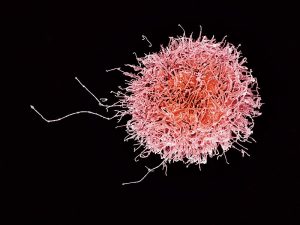Erika Siren lives in Vancouver, British Columbia where she is currently a Ph.D Candidate in the University of British Columbia’s Department of Chemistry. Under the supervision of Dr. Jayachandran Kizhakkedathu, Erika develops biomaterials that can be used to manipulate the immune system. Away from the bench, Erika has a keen interest in the challenges that face the commercialization, policy development and public perception of therapies in regenerative medicine. Connect with Erika on Linkedin here.

Human NK cells. (Credit: Wiki Commons)
While the buzz surrounding immunotherapy has long been dominated by CAR-T cells, a recent discovery from the University of Minnesota may bring forward something new to talk about. Highlighted in the June issue of Cell Stem Cell, research led by Dr. Dan Kaufman and Dr. Branden Moriarity has successfully developed a new type of cancer-targeting cell therapy using Natural Killer (NK) cells. Derived from induced pluripotent stem cells (iPSCs), the aptly named NK-CAR-iPSC-NK cells have demonstrated notable advantages over other cell therapies – both from a therapeutic and commercial perspective.
While the display of chimeric antigen receptors (CAR) are an essential component of cancer-targeting immunotherapy, there are several immune cell vehicles that can be used to impart cell toxicity. As the name implies, NK cells have a similar function to T-cells in seeking out and killing cancer cells. Indeed, this is not the first time NK cells have been optioned for immunotherapies. Thus far, however, the therapeutic impact of NK cells has been hampered by their relative inefficacy toward solid tumours, as well as poor survival and proliferation in vivo.
To improve tumor targeting, researchers engineered NK-specific, pro-cytotoxic NKG2D domains into CAR constructs that were subsequently expressed on iPSC-derived NK cells. NKG2D is an activating receptor found on NK cells that is able to both powerfully stimulate cancer cell cytotoxicity (toxicity towards cells) and, more importantly, prolong this behaviour over long periods of time. This dual modification elicited a synergistic effect, providing a potent cancer killing ability in a solid tumour ovarian cancer model, which matched that of CAR-Ts with less off-target cytotoxicity. In addition, the use of iPSCs allowed for prolonged survival of the NK-CAR-iPSC-NK cells when compared to other existing NK cell therapies.
While clearly potent, it may be the ease of commercialization that proves to be the game changing advantage of NK-CAR-iPSC-NK cells over CAR-Ts. Like other cell and tissue transplants, the surface markers on CAR-Ts must “match” that of the recipient. As such, CAR-T cells must be commercially manufactured through a donor-specific, small batch “scale-out” process. During scale-out, T-cells are taken from the patient themselves, engineered into CAR-Ts and then re-administered in a logistically complex and time sensitive manner.
NK cells, however, do not require donor matching; moreover, the iPSC origin of NK-CAR-iPSC-NK cells negates the need for repeated, small batch donor harvesting. Taken together, the need for scale-out can be circumvented as one iPSC donor may be able to provide NK-CAR-iPSC-NK cells for thousands of patients.
With the commercial-scale manufacturing of cell therapies being an ongoing thorn in the side of therapy developers, the newfound ability to make an immunotherapy in a single large batch could potentially lead to cheaper, more accessible therapies.
Unsurprisingly, this technology is already on the path to commercialization. The San Diego-based Fate Therapeutics will be taking the reins in pushing NK-CAR-iPSC-NK cell therapy forward into clinical trials and scale-up. Regardless of the outcome, increased diversification will undoubtedly provide further stimulation to the regenerative arm of the biotech industry. Moreover, if it lives up to the promising early results thus far, NK-CAR-iPSC-NK cells could become a ‘killer’ competitor for existing cell-based therapeutics.
Guest
Latest posts by Guest (see all)
- Regenerative immunotherapy: Hope for chronic autoimmune diseases - September 16, 2025
- Canada’s regenerative revolution: Why AI is the catalyst - September 4, 2025
- Summer by Design: A launchpad for future entrepreneurs and industry scientists - August 14, 2025






Comments